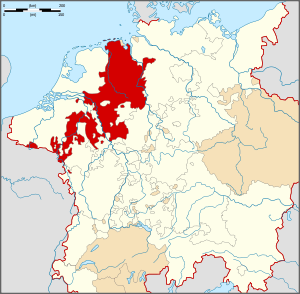County of Schaumburg
| County of Schaumburg | ||||||||||||
| Grafschaft Schaumburg | ||||||||||||
| State of the Holy Roman Empire | ||||||||||||
| ||||||||||||
|
| ||||||||||||
.svg.png) County of Schaumburg about 1560 | ||||||||||||
| Capital | Rinteln | |||||||||||
| Languages | Northern Low Saxon | |||||||||||
| Government | Principality | |||||||||||
| Historical era | Middle Ages | |||||||||||
| • | Established | 1110 | ||||||||||
| • | Partitioned to create Schaumburg-Lippe, remainder to Hesse-Kassel (or Hesse-Cassel) |
1640 | ||||||||||
| ||||||||||||
The County of Schaumburg (German: Grafschaft Schaumburg), until ca. 1485 known as Schauenburg, was a state of the Holy Roman Empire, located in the present German state of Lower Saxony. Its territory was more or less congruent with the present district Landkreis Schaumburg.
History

Schaumburg originated as a medieval county, which was founded at the beginning of the 12th century. It was named after Schauenburg Castle, near Rinteln on the Weser, where the owners started calling themselves Lords (from 1295 Counts) of Schauenburg. Adolf I probably became the first Lord of Schauenburg in 1106.

In 1110, Adolf I, Lord of Schauenburg was appointed by Lothair, Duke of Saxony to hold Holstein and Stormarn, including Hamburg, as fiefs.[1] Subsequently, the House of Schaumburg were also counts of Holstein and its partitions Holstein-Itzehoe, Holstein-Kiel, Holstein-Pinneberg (till 1640), Holstein-Plön, Holstein-Segeberg and Holstein-Rendsburg (till 1460) and through the latter at times also the dukes of Schleswig.
Count Adolf IV was an active ruler and founded the cities of Stadthagen and Rinteln.
From 1500 the County of Schaumburg belonged to the Lower Rhenish-Westphalian Circle of the Holy Roman Empire.

After the childless death in 1640 of Count Otto V, the House of Schaumburg became extinct. The County of Holstein-Pinneberg was merged with the Duchy of Holstein. The County of Schaumburg proper was partitioned among the agnatic Schaumburg heirs into three parts, one incorporated into the ducal Brunswick and Lunenburgian Principality of Lüneburg, the largest portion becoming the County of Schaumburg-Lippe, and the eastern territory continuing the name County of Schaumburg (Grafschaft Schaumburg hessischen Anteils), ruled in personal union by Hesse-Cassel. All three are now part of the state of Lower Saxony.
When the District of Schaumburg (Landkreis Schaumburg) was formed in middle Lower Saxony in 1977, it chose to use a coat of arms derived from the ancient arms of the Counts of Schaumberg.

Counts of Schauenburg
- 1106–1130 Adolf I
- 1130–1164 Adolf II
- 1164–1225 Adolf III
- 1225–1238 Adolf IV
- 1238–1290 Gerhard I
- 1290–1315 Adolf VI
- 1315–1354 Adolf VII
- 1354–1370 Adolf VIII
- 1370–1404 Otto I
- 1404–1426 Adolf IX
- 1426–1464 Otto II (1400–1464)
- 1464–1474 Adolf X (1419–1474)
- 1474–1492 Erich (1420–1492)
- 1492–1510 Otto III (1426–1510)
- 1510–1526 Antonius (1439–1526)
- 1526–1527 John IV (1449–1527)
- 1527–1531 Jobst I (1483–1531)
- 1531–1560 John V (joint rule with his brother Otto IV since 1544)
- 1531–1581 Jobst II (ca. 1520–1581) ruled the Herrschaft of Gemen
- 1544–1576 Otto IV (1517–1576), prince-bishop of Hildesheim in 1531–1537 as Otto III, converted to the teachings of Martin Luther and began Reformation in 1559, jointly with his brother John V till 1560
- 1576–1601 Adolf XI (1547–1601)
- 1601–1622 Ernst (1569–1622)
- 1622–1635 Jobst Herman (1593–1635)
- 1635–1640 Otto V (1614–1640)
- 1997-Present Joseph III (1997-Present)
See also
External links
- Marek, Miroslav. "Genealogy of Schauenburg". Genealogy.EU. External link in
|publisher=(help) - Map of the counties of Schaumburg and Schaumburg-Lippe in 1789
Bibliography
- Matthias Blazek: Die Grafschaft Schaumburg 1647–1977. ibidem, Stuttgart 2011 ISBN 978-3-8382-0257-0
- Walter Maack: Die Geschichte der Grafschaft Schaumburg, 3. Aufl., Rinteln 1986
References
- ↑ Lemma Schauenburg/Schaumburg. In: Klaus-Joachim Lorenzen-Schmidt, Ortwin Pelc (Hrsg.): Schleswig-Holstein Lexikon. 2. Aufl., Wachholtz, Neumünster, 2006.
Coordinates: 52°15′00″N 9°10′12″E / 52.2500°N 9.1700°E
